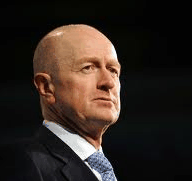
The Reserve Bank of Australia (RBA) has released its quarterly Statement on Monetary Policy (SoMP), which forecasts a slowing of growth throughout the remainder of this year, but an acceleration of growth in the forward estimates.
Below are the RBA’s forecasts from the previous SoMP:
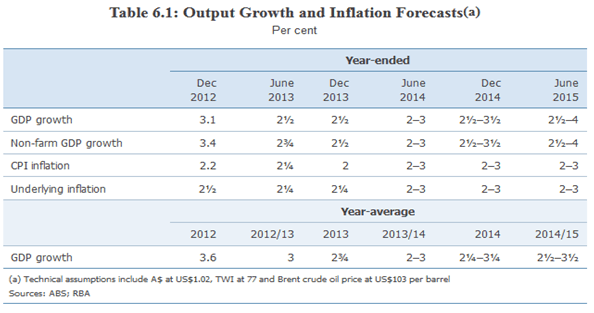
And here’s their latest forecasts:
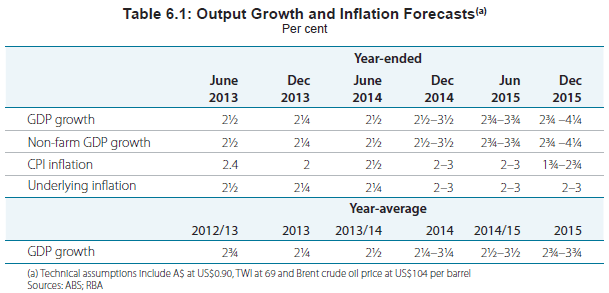
From today’s SoMP:
GDP growth is expected to remain a little below trend at close to 2½ per cent through to mid 2014, before picking up to above-trend growth by the end of the forecast horizon as the global economy experiences above-trend growth and the stimulatory effects of the recent exchange rate depreciation and current low level of interest rates lead to an improvement in business conditions and so investment (Table 6.1).
In the near term, the outlook is a little weaker than that presented in the May Statement, but at the aggregate level it is little changed over 2014. The softer outlook over the next few quarters reflects the somewhat weaker data received since May, for household consumption and business investment in particular. The depreciation since May is expected to bolster growth, working to boost activity in the trade-exposed sector. At the same time though, the profile for mining investment has been revised down. Overall, the change in the forecasts reflects the balance of the boost to activity from the recent depreciation, the recent run of data, and a downward revision to the forecast path of mining investment.
The forecast for consumption spending has been revised lower since the May Statement, with the available partial data pointing to near-term weakness. Retail sales were unchanged in the June quarter, while consumer sentiment has fallen back towards average levels after rising earlier in the year. Slower growth of wages and somewhat subdued employment growth are also expected to continue to restrain growth in labour income. In contrast, conditions and confidence in the established housing market have improved, helping to support growth in household wealth. Overall, growth of consumption spending is expected to be below trend over 2013, before gradually rising to around trend by 2015. The forecasts embody the household saving ratio remaining around the 10–11 per cent range where it has now been for several years.
Importantly, the RBA has revised down the profile of mining investment:
The outlook for mining investment has been revised lower reflecting several considerations. The ABS’ March quarter capital expenditure (Capex) survey recorded a significant decline in mining investment and growth of capital imports remained weak through the June quarter. While the expectations component of the Capex survey remains strong, this is inconsistent with information from the Bank’s liaison, few new commitments to mining projects and a lack of current expenditure on the development and planning work that would typically precede new projects. This is especially noticeable in the coal industry where lower prices of late have led to a significant curtailment of this type of expenditure. Given this, the expectation is that mining investment will decline somewhat over the next year or so before falling away more noticeably thereafter. The impact on GDP will be smaller in magnitude than the decline in mining investment suggests because around half of this investment spending is estimated to be on imported capital goods.
Personally, I feel uneasy about the RBA’s argument that the decline in CAPEX won’t be that severe on GDP since it comprises a lot of imports. Imports were also a key feature when CAPEX was on the rise, yet its impact on GDP was still very pronounced.
Moving on, the RBA doesn’t see much pick-up in non-mining CAPEX:
Overall, non-mining investment is expected to remain subdued in the near term. Surveys of firms’ investment intentions and the Bank’s liaison withfirms suggest that there will be only modest growth over the next year or so. Also, office vacancy rates have increased and measures of capacity utilisation remain a little below average.
But sees a big lift in export volumes:
The outlook for export volumes remains strong with exports expected to make a significant contribution to GDP growth in the coming years… More broadly, activity in the traded sector is expected to be a little stronger in light of the recent depreciation of the Australian dollar.
It sees only modest falls in the terms-of-trade:
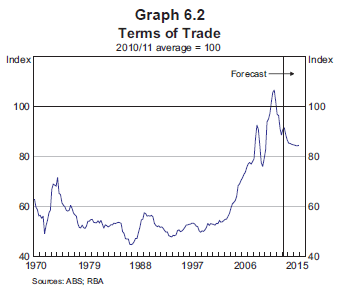
But sees ongoing rising unemployment:
The unemployment rate is expected to continue its recent upward trend over the next few quarters, but stabilise and then start to decline toward the end of the forecast horizon as GDP growth picks up to above-trend rates.
It also notes significant risks in the economy’s transition to non-mining led growth:
The forecast for Australian GDP continues to embody a transition in the drivers of growth from mining investment to other parts of domestic demand, and to exports. There remains considerable uncertainty about how this transition will proceed. In particular, the forecast for mining investment remains uncertain reflecting the timing of investment work on large projects and the possibility of cost overruns. Also, there are still several proposed large projects slated for later in the forecast horizon and there is considerable uncertainty about their prospects. With little planning and development for other new projects underway, mining investment could fall away faster than anticipated. However, with commodity prices projected to only decline modestly, lower domestic costs in foreign currency terms (as a result of exchange rate depreciation and reduced demand for labour inputs from the current big projects) could lead to new projects being slated beyond the next few years.
As well as exchange rate risks:
The path of the exchange rate is an important source of uncertainty for the forecasts. As the terms of trade decline and mining investment falls back from its high level, the exchange rate could depreciate further. This would help to assist with the required rebalancing of growth in the domestic economy, a role the exchange rate has frequently played over the past three decades and in particular during the boom in mining investment over recent years. A significant depreciation can have a substantial impact on aggregate economic activity. There is a wide range of empirical estimates of such effects, which in part depend on whether the depreciation is accompanied by a decline in the terms of trade. Central estimates from this range suggest that a 10 per cent depreciation of the exchange rate stimulates GDP growth by ½–1 percentage point over a period of two years or so. Further depreciation of a similar magnitude to that already experienced to date could, for example, deliver above-trend growth sooner than currently forecast.
As such, the RBA presents confidence intervals based on historical forecast errors for both GDP and inflation:
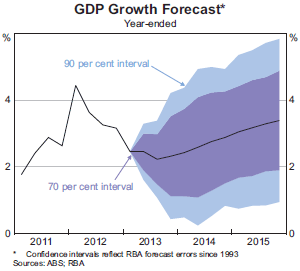
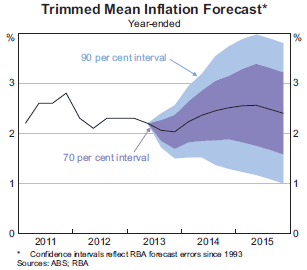
Full Statement below.

